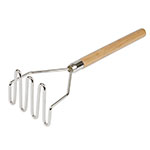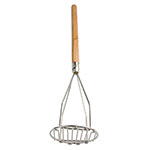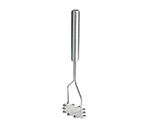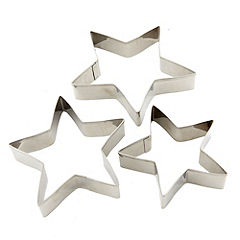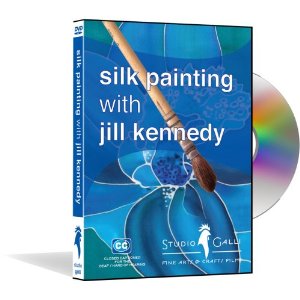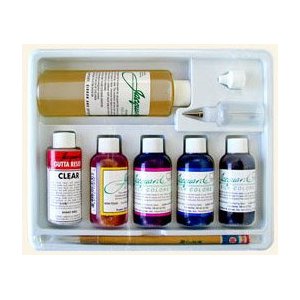« 2012 January | Main | 2011 November »
Thursday, December 29, 2011
Recently the dye in my pole wrap shibori is not pentrating thru the silk crepe fabric--why not?
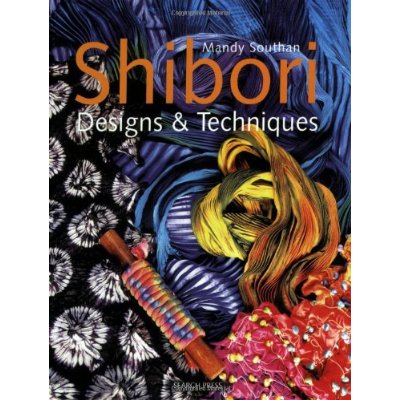

Shibori Designs & Techniques
by Mandy Southan


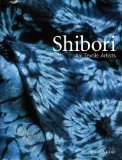

Shibori for Textile Artists
by Janice Gunner


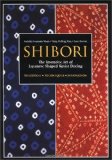

Shibori: The Inventive Art of Japanese Shaped Resist Dyeing
by Yoshiko Iwamoto Wada, Mary Kellogg Rice, and Jane J. Barton


Country or region: USA
Message: I have done pole wrap many times--recently my pole wrap is not pentrating thru the silk crepe fabric--it is only on the top surface--why---have no idea what I am doing wrong--I am submerge dying the pole..any suggestions would be GREATLY appreciated...Joan
Wednesday, December 28, 2011
I want to dye my dark grey jeans black—not navy blue, purple, brown, forest green, or some other color
Country or region: USA
Message: Hi Dr. Burch,
I want to dye my dark grey jeans black. I don't want them to come out navy blue, purple, brown, forest green, or some other color that is not black (and thus too uncool to wear. :-)
What I've gotten from your site is to try to find
"Dylon Permanent black dye, a Remazol dye, which is Color Index reactive black 5."
I hope I can find this stuff. I think there are a lot of "Goth" people hoping for dead black. These are not people who normally dye, but those, like me, who hope that dyeing their not-quite-black clothes will save us from having to discard them and shop for new clothes.
A two-ounce jar of Procion MX dye will dye as much clothing as eight to sixteen packets of Dylon dye. Since a two-ounce jar of Procion MX dyes costs $3 to $6 at ProChem or Dharma, this is much more economical than buying Dylon dyes at $3 per packet, even though the Dylon dye is complete with auxiliary chemicals mixed in, while the Procion dye requires the additional purchase of inexpensive soda ash (or washing soda) and salt. Procion dye must be purchased online if you're not near a particularly good arts supply store. The 20-gram jars of Procion MX dye are less economical than the larger ones, but still cheaper than Dylon. If you are going to be making a habit of dyeing clothing black, as seems logical, you should buy an eight-ounce or larger jar for even more cost savings.
Sunday, December 18, 2011
I am planning on buying either Retayne or Raycafix, but am concerned about the carcinogenic content (formaldehyde)? How dangerous are these?
by Monona Rossol
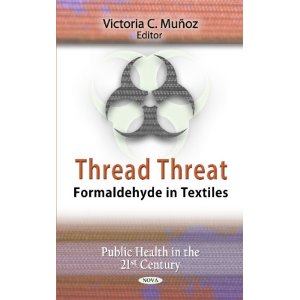

Thread Threat: Formaldehyde in Textiles
edited by Victoria C. Munoz
Formaldehyde, one of the most widely produced chemicals in the world, is used in many products, including disinfectants, pressed wood and clothing and other textiles. Exposure to this chemical, which has been linked to adverse health effects for more than 30 years, typically occurs through inhalation and dermal contact. Formaldehyde can be used to enhance wrinkle resistance in some clothing and textiles, especially those made of cotton.


Country or region: US
Message: Hi, I have just read your article on dye fixatives. Thanks for posting, very informative. I had been told that vinegar worked and before I bought it wanted to check and see if it did, and sure enough it apparently does not! I am planning on buying either Retayne or Raycafix, but am concerned about the carcinogenic content (formaldehyde)? How dangerous are these? It is not worth any amount of risk to me really just to make my jeans darker, but if it's almost nonexistent I would love to try these. Do the dangerous chemicals stay on the jeans after application? Also, it says Raycafix is stronger, is it possible it contains more carcinogens? I would really appreciate any information you can give me. Thanks so much!
Saturday, December 17, 2011
Have you ever used or heard from anyone who has used the Generation Green Colourants?
natural fibers
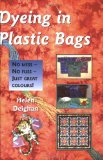

Dyeing in Plastic Bags: No Mess No Fuss Just Great Colours!
by Helen Deighan








Ann Johnston's book
Location: UK
Saturday, December 10, 2011
Do you know of sources for a block of indigo dye?
Friday, December 09, 2011
I want to dye a polyester/nylon blend fabric that is currently black to snow white
Country or region: USA
Message: I have little experience with dyes. I want to dye a polyester/nylon blend fabric that is currently black to snow white. Is that possible? If it is, what's the best way to do it? The fabric is the thin fabric that covers a stereo speaker.
Thursday, December 08, 2011
Looking for wooden tjaps to use for batik
Country or region: Ireland
Message: Hi, I am looking for some wooden tjaps to use for batik- can you recommend a supplier. Also is it ok to use rubber stamps with hot wax?
Sunday, December 04, 2011
I would like to dye white polyester hockey jerseys. Is this doable?
Country or region: Connecticut, USA
Message: I would like to dye white polyester hockey jerseys. Is this doable?
(Please help support this web site. Thank you.)
Friday, December 02, 2011
by Monona Rossol
Recently the dye in my pole wrap shibori is not pentrating thru the silk crepe fabric--why not?
Name: Joan
—ADVERTISEMENTS—
Books explaining shibori techniques
Shibori Designs & Techniques
by Mandy Southan

Shibori for Textile Artists
by Janice Gunner

Shibori: The Inventive Art of Japanese Shaped Resist Dyeing
by Yoshiko Iwamoto Wada, Mary Kellogg Rice, and Jane J. Barton
Country or region: USA
Message: I have done pole wrap many times--recently my pole wrap is not pentrating thru the silk crepe fabric--it is only on the top surface--why---have no idea what I am doing wrong--I am submerge dying the pole..any suggestions would be GREATLY appreciated...Joan
It's very common to see dye not penetrating through to inner layers of the wrapping. Inner layers usually receive noticeably less dye. This is why people devise pole-wrapping setups with large-diameter pipes and plastic trash cans, so that they don't have to place one layer of fabric on top of another. (For example, see this wonderful crank turn version that was posted on the dye forum.)
Traditional Japanese shibori fabric, as used in kimonos, is limited to 14" widths, if I recall correctly. A 14" width of fabric can be accommodated without overlapping layers on a pole whose diameter is only 4.5". With the much greater widths of modern fabrics, we no longer wish to be limited to this size. An eight-inch diameter pipe will accommodate fabric up to 25 inches wide.
Materials that can be used for larger poles depend on your dyeing methods. Dyes that do not require high heat can easily be applied on fabric wrapped around PVC poles, but steaming may soften the plastic. Metal pipes are unsuitable if they are made from reactive metals, such as aluminum or (non-stainless) steel, which will react with the acids used with acid dyes or with the bases used with fiber reactive dyes, with resulting stains and/or alterations in the colors that dyes produce. A Lucite tube will allow you to look inside the pipe to see how well the dye has penetrated. A small stainless steel trash can might work.
Since you have previously been successful in getting the dye to penetrate to the inner layers of your pole wrapping, the best thing to look at now is whether anything has changed in your methods.
- The first possibility to consider is whether your fabric is different from the fabric you use to use. Is it from the same source? Could there have been a change in the processing of the fabric, with different sizings used in manufacture? Of course a thicker fabric, which weighs more grams per yard, will not allow the dyes to travel through it as freely as a thinner, more sheer silk. Do you have any of the old fabric that you used to use, to try for a comparison?
-
Are you wrapping or scrunching your fabric more tightly than before? More tightly wrapped fabric will resist dye penetration more effectively. Even loosely wrapped fabric will tend to get more dye on the outer layers than on inner layers, though.
-
Are you dampening the bound fabric before you apply the dye? Water will resist dye. Dry fabric will absorb more dye. Without presoaking, inner layers will absorb more dye, though not as much as outer layers do.
-
What kind of dyes are you using? Are you using acid dyes, and if so, what brand? Are you using the same colors as before? Different dye colors, even within a single line of dye, are based on different dye molecules, which means they have slightly different properties.
-
Is your dyebath water the same temperature as before? The molecules in hot water move more rapidly and may more easily carry the dye farther.
- Dyes will penetrate further with the assistance of a wetting aid, such as a drop of detergent, or the photographer's surfactant Photoflo. Did you ever use any detergent in your dye mixture before? Some dyes dissolve better with a single drop of Synthrapol or of a hand dishwashing detergent such as Dawn.
If you can figure out what's changed in your techniques, you may be able to return to getting results more similar to what you used to get.
(Please help support this web site. Thank you.)
(Please help support this web site. Thank you.)
Wednesday, December 28, 2011
I want to dye my dark grey jeans black—not navy blue, purple, brown, forest green, or some other color
Name: Liz
Country or region: USA
Message: Hi Dr. Burch,
I want to dye my dark grey jeans black. I don't want them to come out navy blue, purple, brown, forest green, or some other color that is not black (and thus too uncool to wear. :-)
What I've gotten from your site is to try to find
"Dylon Permanent black dye, a Remazol dye, which is Color Index reactive black 5."
I hope I can find this stuff. I think there are a lot of "Goth" people hoping for dead black. These are not people who normally dye, but those, like me, who hope that dyeing their not-quite-black clothes will save us from having to discard them and shop for new clothes.
I like the Dylon Permanent Jet Black, but it's not your only good option, although it is a very good option for dyeing a single cotton garment. The individual packets do not go very far. You need to use two packets to dye a single pound of fabric, but a pair of jeans might weigh more than a pound.
If you have several natural-fiber items that need to be re-dyed black, the best and cheapest method is to use a top-loading washing machine with Procion MX black dye, or use a large plastic bucket and do a lot of stirring. Although the Procion MX blacks are all mixed from different colors, they do not separate out into the constituent colors when used with plenty of water and stirring or agitation. The fact that the Remazol black dye is a single-color unmixed dye is important only if you are dyeing without stirring, as in the case of low water immersion dyeing (which is good for mottled or multicolor effects, but not for a single solid color). It doesn't matter whether the dye you used is pre-mixed from other dyes, if you are only dyeing a single smooth solid color anyway.
You may already have found that all-purpose dyes, such as Rit or Tintex, are not very satisfactory for dyeing clothes black. All-purpose dyes tend to wash out and fade quickly, and people often complain about getting a dark purple or a dark green instead of black when they use poor quality dye. All of the fiber reactive dyes, including both the Dylon Permanent brand and the Procion MX dyes, perform much better on cotton clothing, and last much longer.
The secret to dyeing anything black is always is to use a large amount of dye. No matter what sort of dye you are using, you will generally need to use two to four times as much dye to get a good dark black as you would use for any other color. It takes less to redarken a black garment, though, if there's still a good amount of the original black color present. If you use Procion MX dyes, which are very highly concentrated compared to Dylon or Rit dye, I would recommend 30 grams of dye to color one pound of fabric (weighed while dry) when you're starting from white, or 15 grams of dye powder per pound of fabric if you're starting with something that's a faded black. When in doubt, use more dye, though never more than a total of one-tenth of the weight of the dry fabric. (See my page "How much Procion MX type dye should I use?".) You can use a five-gallon bucket to dye one or two garments, or the washing machine to dye up to eight pounds of garments at a time (weighing them while they are still dry). See "How can I dye clothing or fabric in the washing machine?".
Which of the several black Procion dyes should you buy? They are a little different from each of the different suppliers, but all work well if you use enough dye. For solid black on cotton, I personally prefer black MX-CWNA, which is ProChem's Procion black 608, Dharma's New Black, or Jacquard's Warm Black.
Another important detail to note is that the stitching that holds your jeans together will stay the original color, since almost all clothing is sewn together with polyester thread. The cotton in your dark gray jeans will dye black, while the polyester seams will stay dark gray. That's probably going to be much more satisfactory than the orange thread on blue jeans, though. (See "Dyeing thread in pre-sewn clothing".)
Note that both Procion MX dye and Dylon Permanent dye are good only for natural fibers, such as cotton or rayon. (Rayon is a reprocessed fiber, but it contains cellulose that dyes just like cotton.) If you will be dyeing anything that contains polyester, you will see that the dyes that work on cotton and other natural fibers don't work at all. The dyes for natural fibers will wash out of the polyester fibers. The special dyes that work on polyester require extensive boiling, so you would have to buy a dyeing pot, a much bigger investment than anything you will need for dyeing cotton. There's more information available on my web site, if you decide to go into dyeing polyester.
Be sure to wash clothing very thoroughly before you try to dye it, in the hottest water it can tolerate, to remove finishes and invisible stains that can prevent the dye from reaching the fabric evenly.
(Please help support this web site. Thank you.)
(Please help support this web site. Thank you.)
Sunday, December 18, 2011
I am planning on buying either Retayne or Raycafix, but am concerned about the carcinogenic content (formaldehyde)? How dangerous are these?
Name: Matt
by Monona Rossol

Thread Threat: Formaldehyde in Textiles
edited by Victoria C. Munoz
Formaldehyde, one of the most widely produced chemicals in the world, is used in many products, including disinfectants, pressed wood and clothing and other textiles. Exposure to this chemical, which has been linked to adverse health effects for more than 30 years, typically occurs through inhalation and dermal contact. Formaldehyde can be used to enhance wrinkle resistance in some clothing and textiles, especially those made of cotton.
Country or region: US
Message: Hi, I have just read your article on dye fixatives. Thanks for posting, very informative. I had been told that vinegar worked and before I bought it wanted to check and see if it did, and sure enough it apparently does not! I am planning on buying either Retayne or Raycafix, but am concerned about the carcinogenic content (formaldehyde)? How dangerous are these? It is not worth any amount of risk to me really just to make my jeans darker, but if it's almost nonexistent I would love to try these. Do the dangerous chemicals stay on the jeans after application? Also, it says Raycafix is stronger, is it possible it contains more carcinogens? I would really appreciate any information you can give me. Thanks so much!
I'm afraid I must point out to you that this is a risk you are already taking and have taken for many years. Nearly all cotton clothing that you can buy in the US contains formaldehyde finishes. This is never declared on the label. A garment may be made of 100% cotton and yet be finished with formaldehyde-containing finishes, to give it desirable properties such as resistance to wrinkling. The only exception is clothing whose manufacturer makes specific claims about being free of the usual finishes, or specifically claiming to be free of formaldehyde. This is one of the reasons why you should never wear clothing after purchasing without first washing it at least once, in order to remove the worst of the irritating or even possibly carcinogenic finishes.
(If you are concerned about exposure to formaldehyde, you will also wish to be careful about furniture; furniture made of pressed wood, such as inexpensive furniture from Walmart or Ikea, frequently contains such large quantities of formaldehyde in the glue, holding the strands of wood together into the shapes of boards, that outgassing of formaldehyde from new furniture can reach significantly unhealthy levels in your home.)
The amount of formaldehyde contained in Retayne and other brands of dye fixative is small, though admittedly the very idea of it is disturbing. By law, in the US, the Materials Safety Data Sheets (MSDS) must contain the names of all ingredients which are health hazards that are present at a concentration of 1% or greater, and they must list all carcinogens even if they are present at only 0.1% or greater. An MSDS for undiluted Clariant Cassofix FRN300 (sold as Dharma Dye Fixative) indicates that it contains 2% methanol and 0.5% formaldehyde. This is before the dilution that takes place before a retailer such as Dharma Trading Company sells it to us, so the actual levels as purchased are lower, probably about 0.5% or less methanol and 0.15% formaldehyde. The MSDSs for the Retayne and Jacquard brands of dye fixative do not list any methanol or formaldehyde at all, because, as diluted before sale, their levels are below the legal limits.
In use, these products are, of course, diluted considerably more. The instructions for Dharma Dye Fixative say to use one ounce per pound; if you treat a five-pound load of fabric in a twenty-gallon top-loading washing machine, then the final dilution will be five fluid ounces in twenty gallons of water; twenty gallons contain 2,560 fluid ounces, so the dilution is an additional 1:512. The 0.15% formaldehyde in Dharma Dye Fixative would therefore be diluted to 0.0003%. Much of the formaldehyde and methanol will be washed away with the rinse water, while much of the active ingredient of the fixative, a transparent cationic polymer, continues to cling to the negatively charged dye particles to help fix them in place.
My conclusion is that we don't need to worry particularly about the levels of formaldehyde to these dye fixative products, though it's wise to wear gloves while dispensing them and to use no more than the recommended quantities. I do take care to avoid purchasing furniture made from particle board.
As far as your jeans go, I must warn you that these fixatives might not work! Cationic dye fixatives are not intended for use on neutrally-charged dyes such as indigo. Indigo is used to color most blue denim jeans. Cationic dye fixatives work very well on the cheap direct dye that is used to color a large proportion of commercial natural-fiber clothing. They don't work when the problem is dye that rubs off of a garment when it is still dry, only on the problem of dye that runs when it gets wet, especially in the laundry. With blue jeans, the issue commonly is that the dye is purposefully applied incorrectly, so that the color will wear quickly, making your blue jeans appear worn before much use; this is particularly popular for jeans that are sold prewashed, or that are preworn in some other way.
Unlike Retayne, Raycafix and Dharma dye fixative are claimed to help keep indigo dark longer; I am not sure how well it does so, since that is outside the normal function of this sort of dye fixative. However, the Dharma folks do say in their catalog, "Does a good job with fabric that's been dyed with indigo!!", suggesting that they've tested it, so it's worth a try.
If you want to make your jeans darker than they are now, you can dye them in the washing machine with long-lasting Procion MX fiber reactive dyes, which will need no Retayne or other cationic dye fixative if you follow the standard instructions, using soda ash or washing soda as the dye fixative and salt to help get the best yield from the dye. Dye will color both the light threads and the dark threads in the denim weave, resulting in a much more solid color. This effect may or may not be desirable to you. It is an absolutely formaldehyde-free process, however.
(Please help support this web site. Thank you.)
(Please help support this web site. Thank you.)
Saturday, December 17, 2011
Have you ever used or heard from anyone who has used the Generation Green Colourants?
Name: Linden
—ADVERTISEMENTS—
fiber reactive dyes fornatural fibers

Dyeing in Plastic Bags: No Mess No Fuss Just Great Colours!
by Helen Deighan
Ann Johnston's book
How to do low water immersion dyeing and parfait dyeing with fiber reactive dyes
Location: UK
Message: I was just wondering if you had ever used or heard from anyone who has used the Generation Green Colourants?
I've never dyed anything before and these sound perfect for what I'm after - something for dyeing small amounts of fabric, like rib trims and dyeing over old t-shirts. I'm impressed by the eco claims too.
Do you think these are worth investing in? Do you think they will perform as well as they claim or should I just jump in with one of the fibre reactive dyes you reccomend?
I think it's the idea I can do all the dyeing in a ziploc that swayed me, that and the price.
Would appreciate your advice.
I've never dyed anything before and these sound perfect for what I'm after - something for dyeing small amounts of fabric, like rib trims and dyeing over old t-shirts. I'm impressed by the eco claims too.
Do you think these are worth investing in? Do you think they will perform as well as they claim or should I just jump in with one of the fibre reactive dyes you reccomend?
I think it's the idea I can do all the dyeing in a ziploc that swayed me, that and the price.
Would appreciate your advice.
This is the first I've heard of the Earth Safe Finishes coloring system. It does not include any dye; instead, it contains pigments, which must first be mixed with a fabric medium to enable them to color fabric. This means that they are fabric paints, not dyes.
Dyeing in a zip-top freezer bag with fiber reactive dyes (such as Procion MX dye or Remazol dye) is very popular and easy, so don't think you have to buy into this system to use that technique.
I think the price claims on the Generation Green fabric paints are exaggerated. They say you can make 12 gallons of "dye" (note: it's not really dye!) for as little as two cents an ounce, which sounds cheap, but you'd have to buy many more bottles of the FabricMagic to mix up that much fabric color. Their recipe calls for four parts of water to one part FabricMagic (the thin colorless acrylic fabric paint binder) plus "several drops" of Colorant pigments. Each $30 kit contains a 4 ounce bottle of FabricMagic, which will make up to twenty ounces (600 ml) of the mixture, for $29.95. Additional bottles of FabricMagic cost $5.99. You can't use the Generation Green pigments without FabricMagic or another binder to glue the tiny particles of pigment to the fabric, because they are not true dyes and will not stick to the fabric without it.
It's hard to know how much of this "dye" mixture (actually a thin fabric paint) is needed per pound of fiber to be dyed. If you're not concerned with getting a solid single color, you might be able to color one t-shirt, or one yard of fabric, in as little as two cups of this mixture, so perhaps you could do up to eight t-shirts with one 4-ounce bottle of FabricMagic, though a solid color would require considerably more volume to get the color smooth.
For comparison, a two-ounce jar of Procion MX dye powder costs as little as $4 (depending on your supplier) and will make about twelve cups of dye concentrate for tie-dyeing; for solid-color immersion dyeing, a two-ounce jar of Procion dye powder is enough for eight pounds of fabric, or sixteen adult t-shirts. The soda ash required to fix the Procion MX dye is very cheap; it costs about twenty cents for enough to fix the dye on one whole pound of fabric.
So, Generation Green is not nearly as cheap as fiber reactive dye. It might well be worth what it costs if you like it, though. (It may be more cost-effective than other brands of fabric paint, which are sold with the binder pre-mixed with the pigment.)
What are the other pros and cons of pigments, as opposed to dyes?
Wear: The Generation Green system, like all fabric paints, is more susceptible to wear than true dyes, because the particles are essentially glued to the outside of the fibers in your fabric, rather than being chemically attached to the insides of the fibers, as dye molecules are. When the outside of the fiber wears off, the color is gone, much more quickly than when a true dye is used to color each fiber both inside and out. The faster wearing off can be a good thing, when the appearance of wear is desired. Pigment dyeing is often used for clothing when a look of instant age is desired. You should consider whether this effect will add to or detract from your work.
Smooth even color: fabric paints do not, as a rule, give as perfectly smooth a color as fabric dyes can. As the binder dries, pigment particles tend to migrate into the wetter parts of the fabric, resulting in inconsistent color. In addition, as with dyes, in order to get the smoothest overall color, you must use a large amount of water in which to suspend the pigment particles, and you must use continuous agitation. Neither a large volume nor constant agitation are included in the methods listed among Generation Green instructions, so perfectly solid colors are unlikely. However, you might not care about getting a smooth solid color. Don't think that that means you must use a pigment system, though, since the dye technique known as Low Water Immersion (LWI) dyeing is a good method for using true dyes to produce a variegated appearance.
Color mixing: often people complain that it's harder for them to mix colors with fabric paints than with true dyes. Procion MX dyes are available in a hundred different pre-mixed colors, in addition to the dozen or so pure mixing primaries, some of which are so close to the printers' primaries of cyan, magenta, yellow and black that they can be used to produce any color imaginable. The Generation Green pigments are available in a range of twenty-five colors, more than in than some lines of true dye, though there is only one blue. The lack of other blue hues is a serious issue. The colors available in the four-color ESF FabricMagic Starter kit appear to be a royal blue, a true red, a yellow, and black; unfortunately, royal blue and true red will not produce as wide a range of colors when mixed as would a system that contains turquoise and magenta, instead.
Convenience: for dyeing very small bits of trim, and for fabrics of unknown fiber content, fabric paints can be more convenient than true dyes. Instead of allowing the dye to react with the fiber, you let the Generation Green pigment/FabricMagic system to dry, and then you heat-fix the acrylic binder in the FabricMagic with a hot iron, which can be less trouble for small pieces. For larger pieces, heat-setting can end up being more trouble than proper dye usage, though. The liquid form in which the pigments and the FabricMagic binder are provided is certainly a convenience. Most fiber reactive dyes are available in powdered form only, which in the case of Procion MX dyes must be mixed up fresh every week or two (though some successfully use refrigeration to keep mixed Procion MX dye fresh enough to use for weeks or months); Remazol fiber reactive dyes can be purchased in a convenient long-lasting liquid form and are midway in price between Procion dyes and the Generation Green FabricMagic system, but they are difficult or impossible to find in the UK. Earth Safe Finishes does not appear to specify whether or not their FabricMagic binder works on synthetic fibers; some brands of fabric paints do not, although some other brands of fabric paints do. If FabricMagic works on synthetic fibers, then it will be particularly convenient for polyester blends, as an alternative to the bother of boiling fabric in disperse dye.
Eco-safe claims: I am not at all impressed by claims that fabric paints and pigments are necessarily safer or more environmentally sound than true dyes. They do have a real advantage when you are under drought conditions, because there is much less washing necessary after coloring with fabric paints than after applying dyes; it is always necessary to wash out excess unattached dye after dyeing, which can use a fair amount of water, but that's usually not much of a consideration for home dyeing. When dyeing solid colors with large amounts of water in huge dyebaths, the amount of salt that is needed is considerable and can be a serious ecological problem; however, many of the methods we use for home dyeing do not require salt, and the quantities of salt required for home dyeing with even the most salt-intensive methods are insignificant due to the small volumes being used. Some pigments are safer than some dyes, but you must check for outside certification by an independent test company for each pigment color in order to be sure of this. Many of the pigments are extremely close in chemical structure to some of the chromophores in the dyes we use, so there's probably not that much difference, as long as none of the pigments are based on heavy metals such as cadmium or chromium (long popular in traditional artists' pigments), and as long as none of the pigments or dyes are based on the dangerous dye intermediates benzidine, o-dianisidine, and o-tolidine (which have been mostly phased out among home-use dyes, and which the makers of the Earth Safe Finishes products have most likely excluded).
In conclusion, if you are planning on dyeing natural fibers, such as overdyeing cotton t-shirts, I recommend that you use fiber reactive dyes, such as Procion MX dye powder or Remazol liquid dyes (also known as vinyl sulfone dyes), instead, as they are less expensive, produce longer-lasting results, and are more versatile. If you have small items of uncertain fiber content, I do recommend a fabric paint, such as Jacquard Dye-Na-Flow, Dharma Pigment Dyes, or possibly the Generation Green pigments with the FabricMagic binder. Since I have not tried the Generation Green system, and have not read any reviews by anyone outside the Earth Safe Finishes company, I can't be sure whether or not it is as good as other brands of fabric paints. It would be wise to purchase the smallest kit available and do tests to see how well it works for you, before making any significant investment in them. Of course, this is good advice whenever you use any new materials.
(Please help support this web site. Thank you.)
(Please help support this web site. Thank you.)
Saturday, December 10, 2011
Do you know of sources for a block of indigo dye?
Name: Phoebe
Country or region: SC, USA
Message: Want to buy a block of indigo dye. I am an educator and want to show children how dye was shipped out of SC. Do you know of sources? Can be synthetic, but prefer the real thing.
Thanks for any information you can supply.
You can order whole lump indigo cake from Aurora Silks.
Most of the natural indigo you find available for sale to hand dyers in the US is pre-ground, which is more convenient to use, but not as suitable for your purpose. I believe the whole lump form is more prevalent in some other parts of the world.
(Please help support this web site. Thank you.)
(Please help support this web site. Thank you.)
Friday, December 09, 2011
I want to dye a polyester/nylon blend fabric that is currently black to snow white
Name: Paul
Country or region: USA
Message: I have little experience with dyes. I want to dye a polyester/nylon blend fabric that is currently black to snow white. Is that possible? If it is, what's the best way to do it? The fabric is the thin fabric that covers a stereo speaker.
Can't be done.
First, you're not talking about dyeing at all. Dye is transparent, so dyeing anything can only add color, making it darker. It can't take away the color that is already there. Any dye applied on top of a dark black will have essentially no effect at all.
So, what you really want to do is remove the dye that is already there, that is, to discharge the dye. To remove dye from a synthetic fiber, never use household bleach, because the hypochlorite it contains will simply destroy nylon, and it will permanently damage polyester in more minor ways. You have to use a sulfur-based color remover, such as sodium dithionite (sodium hydrosulfite) or thiourea dioxide. See "What chemicals can be used to remove dye?". Rit Color Remover is a good choice. This can be done only by removing the fabric from the speakers and cooking it on top of the stove with the color remover you have chosen.
Unfortunately, commercially dyed black items almost never can be discharged to white. Black is often obtained by dyeing with several different colors, or by dyeing with a discharge-resistant dye such as sulfur dye. Synthetic fibers may be colored by having pigments added to them while they are still in liquid form, before they are extruded into fibers; pigments do not respond well to dye discharge. Chances are that, even if you use the most effective discharge chemicals and technique, the best you can do is produce a dull rusty brown. It's unlikely that you will get a color anywhere near white.
Instead, what I recommend you do is go to a fabric store and seek out a similar material in the snow white color you want, as thin and as stretchy as the fabric currently covering the speakers. After removing the original fabric from the speakers, use it as a pattern to cut out new speaker covers, allowing extra width for the margin where you sew the pieces together, which is called the seam allowance. After you have constructed the new speaker covers, turn the fabric inside out, so that your seam allowances and stitching don't show. It's not difficult to get a reasonably good look on speakers if your fabric is thin and stretchy enough. Fiber content is less important for your purpose than the weight and feel of the fabric. You will find that white fabric is more transparent than black fabric, so that it shows more of the inner workings of the speakers.
(Please help support this web site. Thank you.)
(Please help support this web site. Thank you.)
Thursday, December 08, 2011
Looking for wooden tjaps to use for batik
Name: Clare
Country or region: Ireland
Message: Hi, I am looking for some wooden tjaps to use for batik- can you recommend a supplier. Also is it ok to use rubber stamps with hot wax?
I recommend against using rubber stamps with hot wax. I get best results when I melt my wax to at least 230°F, and many rubber stamps will not tolerate that temperature. If you want to test this, use a rubber stamp that you don't much like; do not test this with one of your favorite rubber stamps!
I am not aware of any available wooden tjaps. I think the wooden blocks are more frequently used for printing with fabric paints or thickened fiber reactive dye. Tjaps are more typically made from copper metal.
Dharma Trading Company occasionally has antique used Indonesian copper tjaps. They sell out quickly, even though the prices tend to be quite high, so get on their tjaps mailing list if you want to be notified of future availability. Used tjaps often have significant flaws as the result of much wear. If you find used tjaps on another website, check the date of the listing, because other sources often sell out, too. Textile Techniques in Shropshire England sells both copper tjaps (new ones!) and wooden blocks for printing with dye or fabric paint. They say that you can "even" use the latter to apply hot wax, a wording that suggests to me that they might not expect good results.
Since tjaps can be difficult or expensive to buy, think about ways to make your own. Look at kitchenwares as source materials. A metal potato masher makes a nice shape, with available models including an asterisk shape, a squiggle, or a gridded circle. Consider metal cookie cutters, perhaps using a heat-resistant variety of epoxy glue to mount them onto a small block of wood to serve as a handle. Walk through a hardware store, looking at bolts whose heads may have interesting shapes, or push a pattern of metal thumbtacks into a piece of soft balsa wood. Carving your own wooden tjaps would be time-consuming, but crafts stores sell wooden cut-out shapes for which you could devise a handle. Avoid hot-melt glue, for obvious reasons. Look at the suggestions made by Tie Dye Judy (Judy Sall) entitled "Tools for Waxing" in a discussion entitled Soy Wax Batik on the Dye Forum from October 2007.
Instead of using a tjap, I like to use a tjanting like a pen, or a narrow natural-bristle house painting brush with a wooden handle, to apply hot wax designs onto fabric.
(Please help support this web site. Thank you.)
(Please help support this web site. Thank you.)
Sunday, December 04, 2011
I would like to dye white polyester hockey jerseys. Is this doable?
Name: Jeff
Country or region: Connecticut, USA
Message: I would like to dye white polyester hockey jerseys. Is this doable?
Yes, you can dye polyester, but only with a special kind of dye called disperse dye. You can't use all-purpose dye, nor any other dye that works on natural fibers. See "Dyeing Polyester with Disperse Dyes".
Your polyester hockey jerseys will have to be boiled with the dye, along with an often foul-smelling dye carrier chemical which requires excellent ventilation. You will need a very large cooking pot to do the dyeing in, one which you do not plan to reuse for food preparation. It's best if this pot is made of stainless steel, but enameled steel works well, too. You cannot dye polyester in a washing machine, because your dye water absolutely must be boiling.
If you want the jerseys to be a smooth, even solid color, you will need to use a large enough pot that the jerseys can move very freely as you stir them in the boiling dye, and you will need to stir frequently. If the pot is too small, or if you do not stir enough, then the results will be splotchy, lighter in some areas and darker in others. Your dyeing pot should be big enough to hold several gallons of water, depending on how many shirts you want to dye at a time. One pound of fabric, weighed while still dry, requires three gallons of water; two pounds of fabric require six gallons.
If, instead, you want a tie-dye effect, there are two approaches. One is to tie the shirts and drop them into the pot of boiling dye. The procedure is exactly the same as for solid-color dyeing, but there is obviously less need for care in obtaining exactly the same hue all over the garments.
Another way to apply disperse dye to polyester is to make your design on paper, using crayons or paints made from disperse dye, and then use a hot iron or a t-shirt press to transfer the design. This method works very well and does not require the smelly carrier chemical that is needed for full color intensity in immersion dyeing. This is also a method more suitable to the novice dyer. For an example, see "Iron-on Fabric Crayons for Synthetic Fibers".
You can buy one brand of disperse dye, Jacquard's "iDye Poly", in some of the better crafts or art supply stores; the smelly color intensifier chemical is included in a separate pouch inside the packet. Each packet is good for two to three pounds of dry fabric; weight your shirts before you dye them to see how many packets to dye. There are only eight colors available; be careful not to confuse "iDye Poly" with "plain "iDye", which is a different type of dye that works only on natural fibers.
Otherwise, you will have to buy your disperse dye online. PRO Chemical & Dye, in Massachusetts, sells thirteen colors of disperse dye for immersion dyeing, plus, separately, a dye carrier chemical that is described as being low in odor, though, like the Jacquard Color Intensifier, it requires good ventilation and the use of a respirator. Aljo Mfg in Manhattan, sells twenty-two different shades of disperse dye for polyester, including a true fluorescent red, plus a dye developer chemical; they don't have an online shopping cart system, but you can order from them by telephone.
If this seems too difficult to you, since dyeing polyester can be a real challenge for a novice dyer, then there is one custom dyer available that will dye white polyester garments to order, Metro Dyeing Service; see my page, "Where can I find someone to dye my clothing for me?".
(Please help support this web site. Thank you.)
Friday, December 02, 2011
Message: I am interested in asking other people who use Dupont Dye if they have had any trouble with bladder cancer. My artist friend who has used these products for 20+ years is now recovering from this. There is a lot of info about this generally on the internet, but not much specifically, so I am reaching out.
by Monona Rossol
I think that the Dye Forum would be a good place to ask your question. The H. Dupont silk painting dyes contain many different types of dye. It is possible, though we don't know for certain, that they may have contained benzidine-based dyes at some point in the past. Commonly available all purpose dye certainly did thirty years ago, though now they no longer do, and fiber reactive dyes do not. I don't know if you've already seen my posts and blog entries about bladder cancer, or my posts about H. Dupont dyes.
Almost all of the dyes in the H. Dupont silk dyes are trade secrets. The manufacturers do not reveal to anyone what ingredients they use. You can request MSDS (Material Safety Data Sheet) pages for the current formula of any dye you buy now, many of which turn out to be rather uninformative, indicating that the manufacturers claim that there are no hazardous ingredients; however, you can never find an MSDS for any old formulation of a dye color, and we don't know when or how many times the manufacturers have changed their formulas. Current MSDS pages are required to mention carcinogens that are present at or above 0.1% of the formula, but I fear that there may be no requirement for MSDS pages to be made available for older versions of substances that have been reformulated, once they are no longer being sold. (Only legal action can help with that.) Here is a link to a post containing everything I know about the ingredients in the H. Dupont and similar dyes, which are known collectively as the French silk dyes:
These lines of dye for silk painting mostly contain acid dye and/or basic (cationic) dye, but they can, it turns out, contain almost any sort of dye in some of their color formulas.
We know that all-purpose dyes, including the ones commonly sold in grocery stores, contained carcinogenic benzidine-based acid dyes at least through 1981; see, for illustration, a short article in the July 1982 issue of Mother Jones magazine through Google Books. An important US government document, "Health Hazard Alert--Benzidine-, o-Tolidine-, and o-Dianisidine- Based Dyes" (NIOSH ALERT: December 1980; DHHS (NIOSH) Publication No. 81-106), summarizes the evidence against the benzidine-, o-tolidine-, and o-dianisidine-based dyes that are believed to cause bladder cancer. A more difficult-to-read 1991 journal article about bladder cancer among dye factory workers, "Bladder cancer mortality of workers exposed to aromatic amines: an updated analysis", by G. Piolatto et al [PDF], lists figures for the actual risks of heavy exposure to the dye chemicals benzidine, naphthylamine, fuchsin, or safranine T.
Since we are pretty sure that H. Dupont dyes include acid dyes or basic dyes, and that some formerly commonly used acid dyes and direct dyes were based upon benzidine, o-tolidine, or o-dianisidine, it does not seem unlikely that some colors of the H. Dupont and other secret-ingredient silk painting dyes may once have contained similar hazards. We have no idea when the formulas may have been changed so that this line of dyes no longer contained them. Supposedly, the H. Dupont Silk Dyes were first introduced more than a century ago. MSDS pages have been required only since November 25, 1983, though some existed earlier; I'm inclined to doubt that any MSDS page existed for H. Dupont dyes before then.
Here is a list of dyes that probably cause bladder cancer, from The Artist's Complete Health and Safety Guide, by Monona Rossol, pp 137-139, but with no way to tell which if any of the H. Dupont dyes ever did or still do contain them. Most dyes based on benzidine, o-dianisidine, or tolidine are either acid dyes or direct dyes, so it seems not unlikely that the formulas for H. Dupont dyes and other silk dyes may have contained some of these dyes before 1981. The acid dyes in question include Colour Index acid orange 45, acid orange 63, acid red 85, acid red 89, acid red 97 Scarlet G, acid yellow 42, acid yellow 44, acid red 114, and acid red 167, in addition to a large number of direct dyes. Benzidine-based dyes seem to have been mostly phased out in the US for safety reasons, but the same is not necessarily true for dyes based on o-dianisidine or o-tolidine, which are suspected of producing the same dangers. I think that dyes based on any of these chemicals should be included in a current MSDS, so an MSDS with nothing of interest included in it probably indicates a dye that does not contain them, but I am not certain whether this is universally true.
It's extremely difficult, or impossible, to get any information from a manufacturer who is afraid of legal ramifications. Here is an example of what happened when someone tried to find whether a certain dye made by another dye manufacturer had caused a specific illness:
The dye company refused to give even the full Color Index name of the dye in their product, such as "Acid Red 94"; they gave only the infuriatingly useless information that it contained "Acid Red", without the number that is needed to make this a specific Colour Index name. "Acid Red" without a number could refer to any of hundreds of different dyes, ranging from toxic to totally harmless.
Here are links to my blog entry with a question about fiber reactive dyes from a reader who has bladder cancer and uses a different type of dye than the Dupont series:
and my discussion of benzene and benzidine in fiber reactive dyes:
Although these questions specifically refer to fiber reactive dyes, which as a class seems to be safer than some other dyes, there is also some more general information in them.
Does your friend remember using any other dyes or other likely carcinogens during the nineteen-eighties, such as all-purpose dyes as they were then, cigarette smoke, factory work with chemicals, working as a hairdresser, or exposure to the polycyclic aromatic amines in tattoo ink? Or did she use only H. Dupont dyes? As you already know, the development of bladder cancer often takes twenty-five years or longer after the exposure to the carcinogen, which makes it more difficult to decide what chemicals are most likely have been to blame. With bladder cancer, the development of the disease occurs gradually, in steps, with first one mutation accumulating in the DNA, and then another; it takes a combination of several changes to occur in the same cells for a cancer to begin growing. This means that a person with bladder cancer is at risk for developing new bladder cancers, and must be careful to avoid further exposures to known bladder carcinogens.
If your friend is still working on her art, she will need to know which materials do not place her at additional risk, as she may be especially susceptible to new bladder cancers if she continues to be exposed to chemicals that cause bladder cancer. As far as current and future use of silk dyes is concerned, it seems likely that the H Dupont Dyes do not now contain benzidine-based dyes, and so they should be safe to use with appropriate precautions, such as always wearing gloves to avoid skin exposure, and never eating in the dye studio. (Common advice is also to avoid smoking while using dyestuffs, since artists commonly ingest small amounts of their materials as the result of smoking while working, but of course cigarette smoke is itself a major cause of bladder cancer, and also makes it much more likely that benzidine-based dyes and other carcinogens will succeed in causing cancer.)
To be more certain about the identity and therefore the safety of dyes used for silk painting, I personally feel more comfortable with using dyes whose ingredients are known, such as the Procion H or Remazol (vinyl sulfone) fiber reactive dyes, which are often used for silk painting. (See "About Procion H dyes" and "About Vinyl Sulfone Fiber Reactive Dyes".) None of the Procion H or vinyl sulfone dyes or any other fiber reactive dyes have ever contained dyes based on benzidine, o-dianisidine, or o-tolidine, as far as I have been able to discover. You can also mix your own silk paints from pure acid dye powders supplied by Jacquard Products, PRO Chemical & Dye, or Dharma Trading Company, which provide full information on which exact dyes have been used to mix the colors in these lines of dye (though they don't tell which of these dyes have been used to mix a specific color). Knowing the Colour Index name of each dye is the only way to be sure what hazards you are being exposed to.
When you are using a premixed dye whose ingredients are secret, such as H. Dupont Silk Dyes, Sennelier Tinfex Design, Pebeo Soie, and Kniazeff, you can never have much of an idea of the exact hazards you need to be careful to avoid, though the more dangerous chemicals ought to show up on the MSDS you request for each dye from your dye seller.
Best wishes to your friend in his or her recovery from bladder cancer.
If any silk painting readers have experienced bladder cancer, in their own lives or among their friends, relatives, or colleagues, please join the Dye Forum to discuss whether there's a possible connection with the old formulas of all-purpose dye, direct dye, or any of the French silk paints.
(Please help support this web site. Thank you.)
(Please help support this web site. Thank you.)



